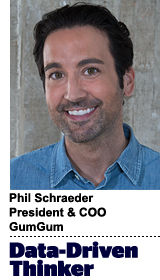 “Data-Driven Thinking” is written by members of the media community and contains fresh ideas on the digital revolution in media.
“Data-Driven Thinking” is written by members of the media community and contains fresh ideas on the digital revolution in media.
Today’s column is written by Phil Schraeder, president and chief operating officer at GumGum.
The question of who exactly bears the responsibility for ensuring brand safety has typically been a gray area, with no one stepping up to own the problem in its entirety.
It’s clear that it’s impossible to completely censor the Internet, or rely on social media sites and publishers for failsafe protection. Brand safety is everyone’s responsibility, said 4A’s EVP Louis Jones, with brands, agencies and platforms acting like “three legs of the stool.”
While this comment is a step in the right direction, I believe that today’s brands and agencies must each take a leading role in assuming a greater degree of responsibility by investing in the necessary manpower and infrastructure to protect against online risks.
Both brands and agencies need brand safety officers to monitor content of the ad ecosystem, as these are the organizations that are likely to care the most about how their brands are perceived by their consumers. While publishers and platforms also have a role to play, they don’t have the same skin in the game.
A brand’s brand safety officer would then have the sole responsibility for determining brand safety policies, liaising with key partners to ensure a high level of compliance nationally and educating and communicating with marketing peers and other executives across the company.
Constant challenges
The definition of “unsafe content” is nuanced and arguably requires more attention than it has been given. Keywords, for example, are not always precise: A news story about a bomb cyclone could be blacklisted even though the content has nothing to do with terrorism. And if a brand stays away from platforms and sites with potentially controversial content, such as CNN, there’s a risk of missing large, quality audiences.
For brands, the brand safety officer should articulate a clear strategy and plan that is aligned with the company’s industry, audience and internal culture. The officer also needs to understand the subtle nuances and preferences of audiences in each geographic location, especially for national or international brands. Brand safety standards are not a one-size-fits-all approach.
For example, what might be considered brand-safe content in New York or Los Angeles could be perceived as offensive in a smaller city. Brand safety officers can help create guidelines to dictate these subtle differences across all regions. They should also ensure that partner organizations provide full transparency into their efforts for enforcing their individual brand safety strategy. It will also be up to them to help teams understand key safety tools and choose partners that adhere to industry policy and fraud-related best practices.
For agencies, a brand safety team should cover all areas of risk in the digital inventory supply chain and ensure close cooperation and contractual protection. Agencies also have a role to play in the sense that they have a deeper understanding of the ad ecosystem. Being that they are much closer to publishers, ad servers and brand safety providers, agencies often have intimate contract knowledge and are well-positioned to support the safety guidelines outlined by the brand.
Publishers also have an obligation to ensure their platforms meet expected standards and take the necessary steps to create a safe online experience for consumers. Publishers are in the unique position of having to deal with both the interests of their readers – who will inevitably demand all sorts of content, including brand-unsafe content – and the interests of brands. A senior executive responsible for the interests of brands is essential to ensure greater alignment between their needs and the needs of the consumer.
For example, if a publisher has a piece about the Great Pacific garbage patch, this executive can work with the brand, agency and ad tech vendors to ensure that ads for garbage bags don’t show up next to this article.
Industry developments
Many brands, including JPMorgan Chase and Bank of America, agencies including IPG Mediabrands and GroupM and platforms such as Facebook have already invested in new roles dedicated to the cause. Chief media officers, brand safety officers and managing partners for brand safety are important, newly-created roles that point to a greater commitment to safer online environments.
The Brand Safety Institute was launched in July, formed by Mike Zaneis, president and CEO of the Trustworthy Accountability Group, and Neal Thurman, director at the Coalition for Better Ads. The organization will define best practices, provide a certification program for the new brand safety officer role and offer other kinds of supporting education, training and resources.
An investment in creating brand-safe environments and building trusted partnerships is good business sense for everyone. The time for clear ownership of this issue is desperately overdue; dedicated roles and teams working together to identify and fix brand safety problems could represent a huge step forward.
Follow GumGum (@GumGum) and AdExchanger (@adexchanger) on Twitter.
This post was syndicated from Ad Exchanger.


More Stories
L’Oréal partners with WPP for influencer growth
Warner Bros. Discovery CEO David Zaslav Receives $51.9 Million Pay Package for 2024
TikTok Fave Duolingo Boosts YouTube Shorts Viewership 430% in One Year